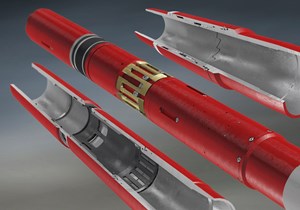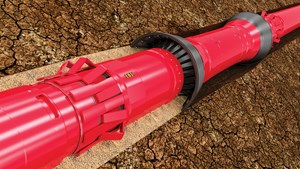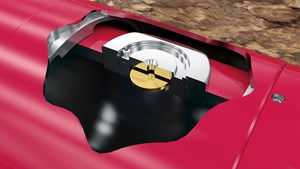Sand control technology advancements improve the cost and efficiency of completions
The days of completing mostly low-deviation wells using cased-hole gravel packs—either single-zone gravel packs or dual-zone stacked gravel packs—are long over. Operators now demand optimal production over an extended productive lifecycle. This demand has led to the development of more complex reservoirs: more remote locations; greater depths, including deep and ultra-deep water; higher deviations; and longer laterals and open holes for increased reservoir contact.
Despite the complexity of today’s reservoirs, operators want to complete wells and get them to production faster. Service providers, in turn, are looking to shorten time to production by reducing installation times, eliminating the need for intervention and workovers, and limiting nonproductive time (NPT)—all with the objective of lowering capex and reducing the cost per barrel.
Regular advancements in completion technologies play a critical role in achieving these objectives. Each trip downhole could add millions of dollars in cost, but new technologies are capable of minimizing trips downhole—a huge potential impact on overall well-development costs. Because new downhole technologies can be remotely controlled from the surface, operators can eliminate the need for interventions to shift or shear tools. Operators also can accomplish more in a single trip. All of this saves time while reducing complexity and risk.
CHALLENGES WITH SAND CONTROL
Developing complex reservoirs involves a higher level of risk, including increased sand exposure. Sand is a major issue, with the potential to diminish well productivity, shorten well life, and erode downhole equipment—driving the need for increasingly costly production systems and facilities at the surface. In terms of sand production, the primary challenge facing the industry right now is assuring reliable, long-term sand control. Subsea production systems have zero tolerance for sand production—and this is one environment in which encountering sand is a near certainty.
Around the world, sand production has shut in thousands of wells, and resulted in millions of dollars lost in deferred production and workover costs. Especially in subsea or remote reservoirs, it is extremely challenging and expensive to get shut-in wells cleaned out, repaired, and back on production. The lack of sand control technology, or the failure of installed technology, allows this problem to perpetuate. The industry must meet this challenge by designing and deploying robust sand control technologies moving forward.
For these reasons, the industry is shifting from a reactive mindset to a proactive mindset toward sand control. Previously, most operators would defer the costs of managing sand production until a problem had actually happened. But with sand production, and the ensuing loss of sand control, becoming a more common issue, people are starting to see the value of having a sand control strategy in place during the initial stages of planning well completions. By installing sand control technologies at the outset, operators reduce the need for interventions later in the well lifecycle and save costs in the long term.
Open-hole completion technologies that enhance sand control—including stand-alone sand screens, inflow control devices (ICDs) and horizontal gravel packs—have advanced significantly over the years, to make the development of challenging, sandy wells not only possible but also economically feasible. Stand-alone screens have enabled the completion of longer laterals and highly deviated, horizontal open holes. ICDs have helped to balance the inflow profile of long horizontals, which has resulted in a uniform flow distribution from heel to toe. This increases the productive sweep of reservoirs and extends the overall productive life of wells. Horizontal gravel-pack and expandable screen technologies offer a conformable solution for unconsolidated reservoirs to minimize the movement of fines.
For sand control, these advances in open-hole completion technologies mean better target selection, optimized drill-in fluids, more effective hole cleaning, improved filter cake breakers, and more reliable, long-term barriers. All of these advancements enable sand-free production and life-of-well productivity across reservoirs.
NEW SAND CONTROL TECHNOLOGIES
Weatherford has introduced several new sand control technologies that overcome many of the challenges operators face while simplifying operations, enhancing reliability, saving time, and reducing capex—even in the toughest operating environments. These technologies all meet the requirements of an intelligent completion, and represent the direction that advanced completion and sand control systems are moving toward.

Single-trip, open-hole, multi-zone gravel packing. The WFX0 gravel-pack system is an API/ISO V0-rated, complete gravel-pack system. It also enables single-trip, open-hole, multi-zone gravel packing from a single position in the completion string, Fig. 1.
With a modular design that can be customized to suit unique needs, the system leverages many advanced completion technologies to accomplish reliable, gas-tight reservoir isolation. The system combines three core elements—the gravel-pack packer, closing sleeve, and quick connect, all of which have earned a V0 gas-tight rating—with other components that include shunt-tube-technology (STT) sand screens and the TerraForm SZE open-hole packer. Together, these technologies can reduce interventions, trips downhole, and unnecessary costs.
STT sand screens enable single-trip gravel-packing by providing an interrupted flow path for gravel-pack slurry that extends to all producing zones in a single pump operation. Shunts run across the entire length of each screen to easily pack voids between the screen and borehole. This simplifies and shortens gravel-packing operations, and reduces the time and costs of repeatedly deploying the gravel-pack assembly.

The TerraForm packer uses proprietary tension-set, cup-seal-isolation technology and a unique clutch mechanism to provide selective, life-of-well zonal isolation without inducing stresses into reservoir rock that could lead to fractures, Fig. 2. Additionally, 24 independent setting mechanisms around the elastomer seal enable the packer to expand to seal irregularly shaped wellbores. The result is cased-hole functionality in open-hole, non-uniform wellbores across multiple zones. Because operators no longer have to run casing across the productive interval and then cement and perforate casing, the completion cycle can be cut from 30 to 40 days down to as little as 10 days, depending on the number of discrete zones that an operator needs to gravel pack and produce. The time and operational savings could eliminate as much as $20 million from the capex budget.
The packer can be run as part of the gravel-pack system, or individually. In the Gulf of Mexico, an operator needed to complete an extremely deep well, in which each trip in and out of the hole could take up to 12 hr. The approximate daily operating cost of the drillship easily reached $1 million per day—not including the large number of support vessels required to remain in the area to service the completion. For these reasons, the operator needed to convert its planned cased-hole completion into an open-hole completion, to reduce costs and trips downhole.
The packer was chosen for this particular deepwater operation. By installing a TerraForm packer between each open-hole zone prior to setting the upper frac-pack packer, each zone was isolated from the next, while the completion string was centralized and anchored in place. The packer conformed successfully to the formation while maintaining a strong anchor force that avoided damaging the formation. Ultimately, the packer saved the client $20 million in rig time, tubular running services, liner hangers, cement, and cementing products. Because the packers set hydraulically at different pressures, to give each packer a chance to anchor in place and conform to the formation, the operator did not have to run any intervention jobs associated with setting the packers.
Self-mitigating sand screens. The MazeFlo screen is a self-mitigating sand control technology. Developed in partnership with Exxon Mobil, the screen prevents a loss of sand control caused by erosional damage to the screen. Unlike a conventional, single-filter sand screen, the new screen has a unique maze design—with no moving parts—that contains sand ingress without interrupting production.
The screen has a series of compartments along a selectively perforated base pipe. Each compartment has a primary screen, flow baffles, an outer housing, and a secondary screen. Sand flows through the primary screen first. If sand erodes the primary screen, the sand flows into the housing compartment and accumulates on the secondary screen, which increases the resistance to flow in the problematic compartment. Produced fluid is then diverted to the adjacent undamaged screen compartments. In this way, the screen resolves the problem of sand damage without surface intervention.
Recently, the screen was installed in an offshore, horizontal well near Nigeria that had initially produced without any problems, until high sand production shut in the well. The operator needed a remedial sand control solution that would not require additional intervention and would fit within the inside diameter of the liner while still providing a large enough tubing size to avoid restricting flow. Fifty screen joints with 150 compartments were installed along 1,500 ft of 41⁄2-in. horizontal pre-drilled liner. After the workover, the well was brought back on production successfully. The screens eliminated sand and water from production. Gas output remained steady at pre-workover levels, and oil production actually increased to three times its original rate.

Autonomous inflow control devices. Long horizontal wellbores can increase reservoir productivity; however, reservoir heterogeneity and uneven pressure levels, saturation, and permeability along laterals can result in unwanted water and gas breakthrough, which can then increase sand production and overwhelm oil output. Conventional ICDs mitigate this issue by imposing pressure drops to restrict flow and to balance production profiles along laterals. The main limitation associated with conventional ICDs is that they are passive. Once installed, they do not allow for adjustments, should water, gas or other high-mobility fluids break through. Their primary role is to simply delay water and gas breakthrough. With conventional, passive ICDs, well production suffers, or ends completely, after a breakthrough.
In comparison, the FloReg autonomous inflow control device (AICD) not only delays water and gas breakthrough, it also reduces the proportion of the breakthrough—without requiring intervention. Each pressure drop in the AICD is dependent upon fluid viscosity and mobility, Fig. 3. It has active flow-resistance functionality that imposes higher pressure drops for low-viscosity fluids, such as water and gas and lower pressure drops for viscous oil. As a result, well performance can actually improve after a water or gas breakthrough. Both oil recovery and the life of a well can be maximized with this technology.
THE POTENTIAL OF INTELLIGENT COMPLETIONS
Today, the industry understands “intelligent completions” as systems in which rig crews can manipulate downhole tools from the surface, using control lines or TEC lines. The shift toward acquiring downhole data through remote monitoring is a critical enabler of intelligent completions. By gathering diverse types and greater quantities of reservoir data in real time, operators can gain a comprehensive view of downhole conditions, make more informed and timely decisions to mitigate sand production, and extend the life of wells without intervention or costly workovers.
Today, advanced optical monitoring technologies, such as those included within the OmniWell reservoir monitoring system, can be placed deep into the wellbore in direct contact with the reservoir and sand face. Even in conditions with high pressures and temperatures, shock, and vibration, such as subsea environments, the reservoir data are highly reliable because only durable optical components are placed downhole, while more sensitive electronic equipment is retained at the surface. By placing the sensors across the entirety of the completions string, operators acquire information across the whole productive interval instead of at a single point in the completion string. Downhole data can include pressure, temperature, flowrates, water and gas cuts, and information about asphaltene or scale production across the reservoir. The data can then be used to manipulate sand control and completion equipment in real time.
The next step is to manipulate sand control and completion equipment without the need to run wires from the surface. Future intelligent completion technologies will not only be able to detect problems downhole, but correct them without human intervention. The future of intelligent completions also may include sensors that monitor the buildup of scale, anhydrites and asphaltenes by incorporating materials that are sensitive to changes in well conditions, such as pH.
CONCLUSION
Reservoirs are increasing in complexity—and so are the challenges in completing these wells and preparing them for optimal, long-term production. Fortunately, the industry’s understanding of how sand production can be managed, and even eliminated, to avoid losses of control and shutting in wells, is advancing. This greater understanding is reflected in the newest technologies available on the market. Future technology development points toward even more intelligent completions that better protect wellbores from sand intrusion, using less human intervention—with the potential to save significant time and cost. ![]()
- Advancing offshore decarbonization through electrification of FPSOs (March 2024)
- Shale technology: Bayesian variable pressure decline-curve analysis for shale gas wells (March 2024)
- What's new in production (February 2024)
- Subsea technology- Corrosion monitoring: From failure to success (February 2024)
- U.S. operators reduce activity as crude prices plunge (February 2024)
- U.S. producing gas wells increase despite low prices (February 2024)
- Applying ultra-deep LWD resistivity technology successfully in a SAGD operation (May 2019)
- Adoption of wireless intelligent completions advances (May 2019)
- Majors double down as takeaway crunch eases (April 2019)
- What’s new in well logging and formation evaluation (April 2019)
- Qualification of a 20,000-psi subsea BOP: A collaborative approach (February 2019)
- ConocoPhillips’ Greg Leveille sees rapid trajectory of technical advancement continuing (February 2019)


